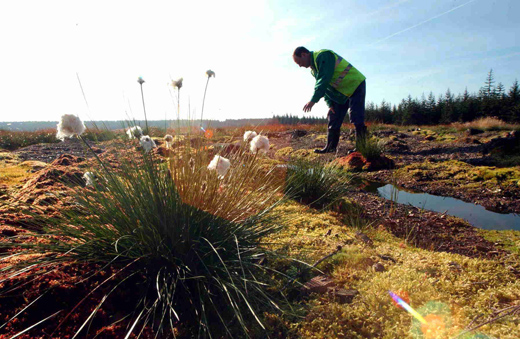£1m pledged for historic Border Mires
Major boost for efforts to revitalise more of the north’s peat bogs
20 January 2022
One of the UK’s most important peatlands is set for another stage of crucial restoration work to help tackle climate change and boost biodiversity.
The Government has pledged £1 million through its Nature for Climate Peatland Grant Scheme, administered by Natural England, to help Forestry England bring a further nine ancient bogs in the historic Border Mires into good health.
The mires lie between Hadrian’s Wall and the Scottish border, spanning both Cumbria and Northumberland. They are a vast area of peat including a network of at least 52 individual sphagnum bogs, many of which are within Kielder Forest. Dating back to the last Ice Age, peat in this amazing and internationally important ecosystem can be over 10 metres deep in places.
Kevin May, from Forestry England, which secured the grant on behalf of a coalition of partners, explained:
“Working with other organisations we have been able to blaze a trail in the long term restoration of peatland here in the Border Mires. We have balanced this with meeting other national objectives, such as vital woodland creation and sustainable timber production. With two other large scale peatland schemes already under our belt the outlook for these historic and fragile habitats is improving all the time. Modern forests are a blended mosaic of resilient open and wooded landscapes. That is exemplified by the Border Mires, which nestle within productive native and coniferous woodland. This vital support from the Government and Natural England will accelerate the evolution and relevance of our forests.”
The scheme, covering 827 hectares, will run for four years and will also be used to help train the next generation of peat ecologists at the University of Newcastle upon Tyne, with students offered opportunities to conduct research and gain experience.
Work will include blocking 24 kilometres of drainage ditches and removing trees to help raise the water table, allowing bogs to grow and lay down new peat
The importance of the Border Mires was recognised in the 1950s and conservation efforts started in the seventies, making it the longest running environmental scheme of its kind anywhere in the UK. Some of the early pioneers are still involved in the project.
In the Middle Ages they were a refuge for bandits called Moss Troopers and they remain a key habitat for sphagnum moss, bog asphodel and carnivorous sundew plants, dragonflies and wading birds. They also lock away carbon in the peat and so play a vital role in mitigating the effects of climate change.
Since 1986 their restoration has been overseen by the Border Mires Management Committee, which comprises Forestry England, Northumberland Wildlife Trust, Natural England, Ministry of Defence, Northumberland National Park Authority and the University of Newcastle upon Tyne.
Marjorie Davy, from Natural England, added:
“This is really great news. The Border Mires are exceptionally important for peatland conservation, with extensive deposits of very deep peat that will continue to grow when the right conditions are re-established. The long-term absence of burning and grazing from many of the sites means that species that have been lost from most bogs elsewhere in England are still well-represented here, including Baltic bog-moss, few-flowered sedge and great sundew. There is much work still to do here, but this funding will build on the great work done so far to bring these ecosystems back to good health, and will set up the next chapter in the story of the restoration of this inspirational, unique and naturally carbon-rich landscape.”
The latest phase of work will see spruce regeneration cleared on areas previously felled and trees taken off another 24 hectares of so far unrestored bogland. This will involve volunteers and Forestry England contractors using high-tech, but low impact cutting machines.
The largest of the mires included in the scheme will be Butterburn Flow in Cumbria, close to RAF Spadeadam where the MOD have secured additional funding to restore another Border Mire known as Berry Hill. All the other sites are in Northumberland.
